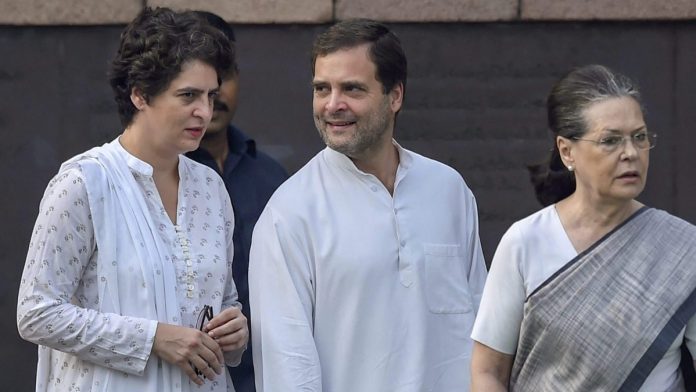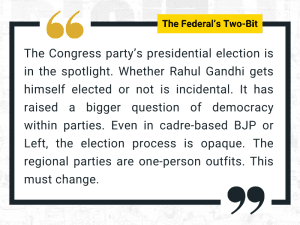
Cong president poll: Long history of piqued equations, battles
The latest contest resembles a poll held in the party way back in 1969. That election, to pick the party's candidate for the President of India post, eventually led to a split in the Congress and the emergence of a leader with unbridled power - Indira Gandhi

Strangely, a few political pundits have gone a bit too far by digging out similarities between the upcoming Congress elections for the party president’s post and that of the recently-held election of the British Conservative Party to elect the Tory chief or Britain’s Prime Minister.
But they seem to have somehow missed comparing this tussle with a battle fought closer home for Congress’ top leadership that had taken place in the past, even as the grand old party once again finds itself staring at a possible split. This was the case way back in 1969.
The next month’s party polls for the new Congress president inevitably remind us of the election of the President of India in 1969. The fate of the Congress Party had got inextricably linked to the outcome of the President’s poll at that point of time, or to be more exact, a little over 53 years ago from now.

Though when the country elected Draupadi Murmu as President only a couple of months ago, the Congress party remained a bit cold to the President’s election and never offered a candidate from its ranks to challenge her. This is quite unlike what had happened in 1969, when Congress MPs and MLAs were sharply divided over voting between the two candidates vying for the post of the head of the State.
Soon this precipitated a split in Congress. And, ever since, the 1969 contest between VV Giri and Neelam Sanjiva Reddy for the post of President has become a part of Delhi’s political lore. It is also significant since this episode, in turn, transformed the then prime minister Indira Gandhi from Gungi Gudia (dumb-doll – as she was called by her detractors both within the Congress and outside the party) into the undisputed leader of not only the Congress government but also that of the party.
Also read: Why the Congress is still relevant, vitally so
The term – ‘Congress high command – came then to signify the unquestioned authority that Indira Gandhi would get to wield and this power would surpass even that her far more illustrious father Jawaharlal Nehru had enjoyed.
Indira Gandhi’s opponents, who happened to be more senior and more highly experienced than her in politics, were virtually reduced to nothing before her and this was the case with most stalwarts from the Opposition parties as well. So, the question now is, how did this happen and what has it got to do with today’s scenario dogging the Congress Party?
Like the crisis the Congress is facing today, it took over two years of simmering factionalism in the party to degenerate into a split. Indira Gandhi’s story is important because ever since her transformation as the sole top leader of the party, the Congress has followed the high-command model set by her.
But it took time for her to evolve into what she eventually became. Indira Gandhi was brought into politics as information and broadcasting minister at the Centre by Lal Bahadur Shastri, who became the PM after Nehru’s death in 1964. Morarji Desai had relented and relinquished his claim over Prime Ministership in favour of Shastri. This could be possible due to the intervention of Congress president K Kamaraj, who had formed a formidable group of senior leaders in the party dubbed the Syndicate since 1963.
Also read: Cong loyalists make beeline to meet Rahul as Bharat Jodo Yatra enters Kochi
The Syndicate proposed Indira Gandhi’s name for the Prime Minister’s post following Shastri’s death. Morarji did not gracefully bow out of the race this time and Congress MPs had to vote to elect the Prime Minister. With the Syndicate’s support, Indira Gandhi won and Morarji Desai lost. Both Indira and the Syndicate made peace with Morarji by making him deputy PM.
Congress was, however, jolted by electoral reverses both in Parliamentary and Assembly polls that were held within two years of Indira Gandhi’s rule in the year 1967. The Congress could manage only a slim majority in the Lok Sabha and lost polls in several states. The reason behind this was that the parties opposed to Congress forged alliances to put up a spirited united fight against Congress amid growing unrest against the party because of the government’s disappointing performance on the economic front.
When Kamaraj lost out in the race
The country faced severe drought both in 1965 and 1966 and to redeem the flagging economy, Indira Gandhi devalued the Indian rupee by 35.5 per cent in June 1966. This led to resentment among the Syndicate leaders, besides others like the Left and socialists.
Kamaraj became sullen as he was not consulted by Indira regarding the devaluation. But electoral marginalisation in Parliament brought a little more authority to Indira Gandhi since many of the Syndicate leaders, including Kamaraj, lost the Lok Sabha polls held in 1967. He later won a by-poll to come to Parliament but this was not the case with all his peers in the Syndicate who had lost.
The electoral upsets faced by the Congress in the States led to defections, floor-crossing, party hopping and political instability on a very large scale, as most non-Congress governments were mainly coalitions formed by diverse political forces like socialists, and right-wingers that included Jan Sangh and Swatantra Party. And, when S Nijalingappa took over as Congress president from Kamaraj, there were fears that the Centre too may end up having a coalition-run government after the next election.
Soon Nijalingappa thought that a person loyal to the Syndicate should be elected as President of India since the Rashtrapati Bhavan incumbent has quite a bit of discretion to invite the person who can run the government in case the polls throw up a fractured or hazy verdict.
Also watch: Congress President election: Party readies electoral rolls, issues ID cards with QR code
At a party conclave held in July 1969 in Bangalore, Nijalingappa nominated staunch Syndicate hand Neelam Sanjiva Reddy as Congress candidate for the President’s post. Indira Gandhi’s protests against this did not work since the Syndicate had majority in the Congress Parliamentary Board. She retaliated by taking away Morarji Desai’s finance portfolio and, thus, forcing him to resign.
Reddy was opposed by the Jan Sangh and Swatantra Party’s candidate CD Deshmukh. Somehow, Nijalingappa gave an opportunity to Indira to attack Reddy and the Syndicate, as the Congress chief met leaders of the two Opposition parties to ask them to cast their second preference votes, once Deshmukh was eliminated in the first round in favour of Reddy.
Indira Gandhi cried foul over this, blaming the Syndicate for having struck a secret deal with communal and reactionary forces. She refused to issue a whip in favour of Reddy. Instead, she backed VV Giri, who was an independent and yet supported by the Left, by calling Congress MPs and MLAs to vote as per the voice of their conscience. Soon, Giri won, though with a thin majority.
The Syndicate expelled Indira from the party in November 1969 but the support of the majority of Congress MPs not only allowed her to retain power but also saw her through in the party as well. This is how a high-command was once born in Congress, whose huge influence and clout, are still believed to linger with her successors.
Interestingly, successors are also called descendants, heirs, or scions and blamed for resting on the laurels of the past – of perpetuating dynasty so as to trample democracy and more so, intra-party democracy. This is the backdrop that looms over all the efforts to take away the post of Congress president from the dynasty; and there is also resistance against this, as party units in State after State are passing resolutions to urge and rather implore Rahul Gandhi to take the mantle of his forefathers.
So far, elections held for the top party post in Congress have not yielded any result other than what the top party family had desired. Non-prime-family-backed candidates have drawn only a few votes. This was also the case when Sitaram Kesri contested and became Congress president. He had the backing of Sonia Gandhi in the 1997 contest though at that point of time she had not joined active politics. Kesri’s two rival contestants were none other than known party faces, Sharad Pawar and Rajesh Pilot. Yet, both lost badly.
Similarly, when Sonia contested party polls for the top job in Congress in the year 2000, her opponent Jitendra Prasada could not even reach the tally of 100 against the over 7,000 votes polled by her.
Tharoor throws his hat in the ring
Thus, a sense of futility has got appended to the attempts made at contests for the top Congress post. Only Shashi Tharoor has so far shown the inclination to throw his hat in the ring. Ashok Gehlot seems to be still in two minds. Gehlot is said to have the top family’s backing, while Tharoor met Sonia to seek her blessings.
Nevertheless, the turmoil in the Congress over the top post has been festering for the past two years. A group of party satraps have virtually been in revolt over the party being turned into what they call a sort of family closet. No less than 23 of these disgruntled Congressmen have written to the party high command about their reservations regarding the party’s functioning. Three of them – Jitin Prasada, Kapil Sibal and Ghulam Nabi Azad – have left Congress. Others may well be waiting in the wings. So the fear about the party undergoing another split is being greatly felt.
This has also been the case in 1998 and 1977, besides 1969. Each time electoral defeat or reversal has been the reason for the split. This time it is no different and at the root of it is the worst kind of defeats that the party has been notching up for itself for over eight years or so. Party insiders feel that things are about to come to a head with the October 17 polls for the party chief’s post. They indicate the party has suffered an unstated split which is about to be formalised with the polls.


